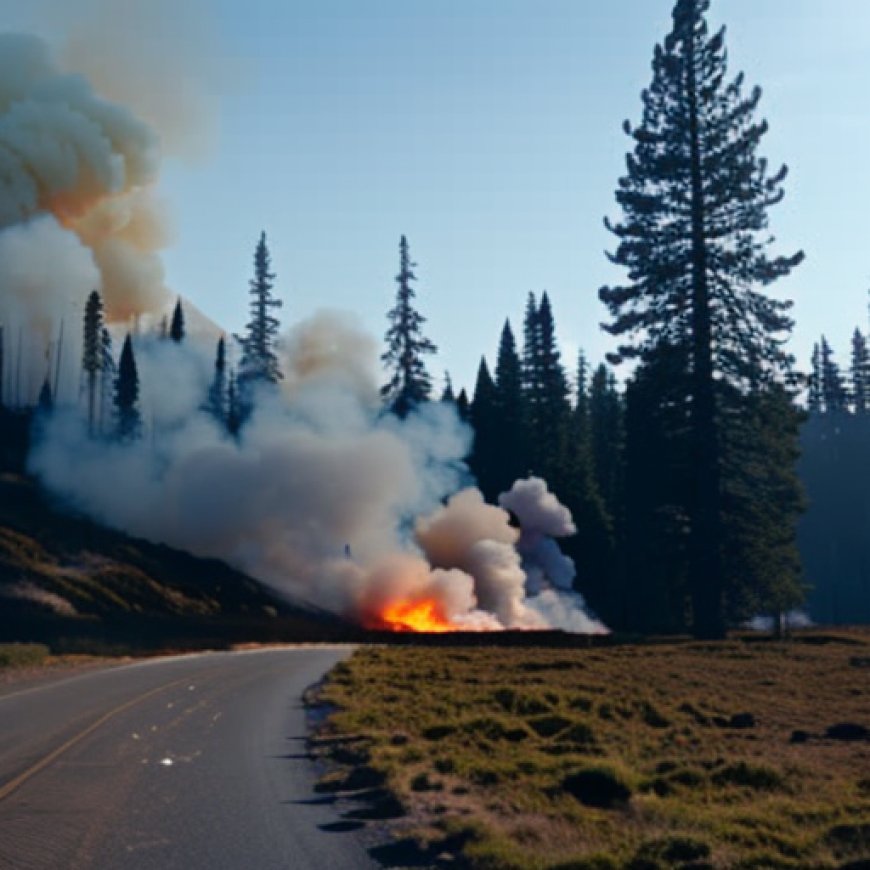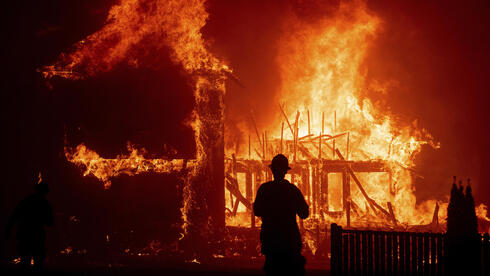Climate change turns wildfires more destructive, study says
Climate change turns wildfires more destructive, study says Ynetnews


Climate Change Increases Risk of Forest Fires

Climate change, which is affecting the entire world, has a variety of destructive effects on the Earth. One of these impacts is evident in the increasing risk of forest fires spreading rapidly. Recent expectations warn that the frequency of wildfires, similar to those seen in Canada, Greece, and Hawaii, will continue to increase if no action is taken to reduce greenhouse gas emissions.
Introduction
Scientists at the Breakthrough Institute in Oakland, California, a non-profit environmental research center, discovered that anthropogenic climate change – in the context of rising temperatures – has increased the frequency of severe wildfires by an average of 25% compared to the pre-industrial era. The study’s findings were published in the Nature Journal.
Research Findings
The researchers used machine learning to analyze a series of wildfires that occurred from 2003 to 2020, to examine the link between higher average temperatures, drought conditions, and the most rapidly spreading wildfires – those burning more than 40,000 hectares per day.
They found that the risk of extreme wildfires could increase on average by 59% by the end of the century in a scenario of low greenhouse gas emissions, limiting global warming to 1.8 degrees Celsius above pre-industrial levels, and up to 172% in a high emissions scenario, mainly driven by carbon dioxide and methane emissions.
Factors Contributing to Increased Risk
Using data from documented wildfires, researchers measured the risk of a specific fire spreading out of control. They then used computer models to calculate how much the post-industrial temperature rise increased this risk.
The study examined variables like topography, wind, and absolute humidity (the mass of water vapor present in a given volume of air or other gas), with the researchers cautioning that these changes might exacerbate the risk even more than global warming.
Examples of Severe Wildfires
For example, California has experienced a series of severe wildfires in recent years. In 2020, fires led to the deaths of more than 30 people and burned an area of over 16 million acres, involving several wildfires that together constituted one of the largest wildfires the western United States had ever seen. Two years prior, a wave of similar fires hit California, resulting in significant loss of property and life.
Link to Sustainable Development Goals (SDGs)
The UN’s environmental plan also addresses this issue. A report published last year on forest fires and their consequences noted that such fires are becoming increasingly common due to environmentally warmer and drier conditions resulting from climate change, even in areas that did not previously experience such conditions.
Preventive Measures and Recommendations
Dr. Patrick Brown, one of the study’s authors, said that insights regarding dry conditions can help in dealing with destructive wildfires and serve as preventive measures. For example, by identifying the best places for thinning vegetation and using controlled burning to reduce the natural dry matter that fuels fires.
“We are finding that under most conditions, the impact of hazardous fuel reductions can completely negate the impact of climate change,” he said. “It is plausible to have a future of much less wildfire danger despite climate change if we conduct these fuel treatments
SDGs, Targets, and Indicators
| SDGs | Targets | Indicators |
|---|---|---|
| SDG 13: Climate Action | Target 13.1: Strengthen resilience and adaptive capacity to climate-related hazards and natural disasters | – Increase in frequency of severe wildfires due to climate change – Increase in risk of extreme wildfires |
| SDG 15: Life on Land | Target 15.2: Promote the implementation of sustainable management of all types of forests, halt deforestation, restore degraded forests, and substantially increase afforestation and reforestation globally | – Destruction of forests due to wildfires – Loss of forest area |
| SDG 11: Sustainable Cities and Communities | Target 11.5: By 2030, significantly reduce the number of deaths and the number of people affected and substantially decrease the direct economic losses relative to global gross domestic product caused by disasters, including water-related disasters, with a focus on protecting the poor and people in vulnerable situations | – Deaths caused by wildfires – Economic losses due to wildfires |
1. Which SDGs are addressed or connected to the issues highlighted in the article?
SDG 13: Climate Action
The article discusses the impact of climate change on the increasing risk of forest fires spreading rapidly. It highlights the need to take action to reduce greenhouse gas emissions to prevent the frequency of wildfires from continuing to increase.
SDG 15: Life on Land
The article mentions the destruction of forests due to wildfires, emphasizing the need for sustainable forest management and efforts to halt deforestation and restore degraded forests.
SDG 11: Sustainable Cities and Communities
The article mentions the deaths caused by wildfires and the economic losses associated with them. It emphasizes the importance of protecting people in vulnerable situations and reducing the direct economic losses caused by disasters.
2. What specific targets under those SDGs can be identified based on the article’s content?
Target 13.1: Strengthen resilience and adaptive capacity to climate-related hazards and natural disasters
The article highlights the need to strengthen resilience and adaptive capacity to climate-related hazards, specifically focusing on the increasing risk of severe wildfires due to climate change.
Target 15.2: Promote the implementation of sustainable management of all types of forests, halt deforestation, restore degraded forests, and substantially increase afforestation and reforestation globally
The article emphasizes the importance of promoting sustainable forest management, halting deforestation, and restoring degraded forests to prevent the destruction of forests caused by wildfires.
Target 11.5: By 2030, significantly reduce the number of deaths and the number of people affected and substantially decrease the direct economic losses relative to global gross domestic product caused by disasters, including water-related disasters, with a focus on protecting the poor and people in vulnerable situations
The article mentions the deaths caused by wildfires and the economic losses associated with them, highlighting the need to reduce these impacts and protect vulnerable populations.
3. Are there any indicators mentioned or implied in the article that can be used to measure progress towards the identified targets?
– Increase in frequency of severe wildfires due to climate change: The article mentions that anthropogenic climate change has increased the frequency of severe wildfires by an average of 25% compared to the pre-industrial era. This can be used as an indicator to measure progress towards strengthening resilience and adaptive capacity to climate-related hazards.
– Increase in risk of extreme wildfires: The article states that the risk of extreme wildfires could increase on average by 59% by the end of the century in a scenario of low greenhouse gas emissions, and up to 172% in a high emissions scenario. This can be used as an indicator to measure progress towards reducing the risk of wildfires and protecting people and ecosystems from their destructive effects.
– Destruction of forests due to wildfires: The article mentions the destruction of forests caused by wildfires, indicating the need for efforts to halt deforestation and restore degraded forests. The extent of forest destruction can be used as an indicator to measure progress towards promoting sustainable forest management.
– Loss of forest area: The destruction of forests due to wildfires can also be measured by the loss of forest area. Monitoring changes in forest area can help assess progress towards halting deforestation and restoring degraded forests.
– Deaths caused by wildfires: The article mentions the deaths caused by wildfires, highlighting the need to reduce the number of deaths and protect vulnerable populations. The number of deaths can be used as an indicator to measure progress towards reducing the impact of disasters on human lives.
– Economic losses due to wildfires: The article emphasizes the economic losses associated with wildfires. Monitoring and assessing the economic losses caused by wildfires can be used as an indicator to measure progress towards reducing the direct economic impacts of disasters.
4. SDGs, Targets, and Indicators
| SDGs | Targets | Indicators |
|---|---|---|
| SDG 13: Climate Action | Target 13.1: Strengthen resilience and adaptive capacity to climate-related hazards and natural disasters | – Increase in frequency of severe wildfires due to climate change – Increase in risk of extreme wildfires |
| SDG 15: Life on Land | Target 15.2: Promote the implementation of sustainable management of all types of forests, halt deforestation, restore degraded forests, and substantially increase afforestation and reforestation globally | – Destruction of forests due to wildfires – Loss of forest area |
| SDG 11: Sustainable Cities and Communities | Target 11.5: By 2030, significantly reduce the number of deaths and the number of people affected and substantially decrease the direct economic losses relative to global gross domestic product caused by disasters, including water-related disasters, with a focus on protecting the poor and people in vulnerable situations | – Deaths caused by wildfires – Economic losses due to wildfires |
Behold! This splendid article springs forth from the wellspring of knowledge, shaped by a wondrous proprietary AI technology that delved into a vast ocean of data, illuminating the path towards the Sustainable Development Goals. Remember that all rights are reserved by SDG Investors LLC, empowering us to champion progress together.
Source: ynetnews.com

Join us, as fellow seekers of change, on a transformative journey at https://sdgtalks.ai/welcome, where you can become a member and actively contribute to shaping a brighter future.







